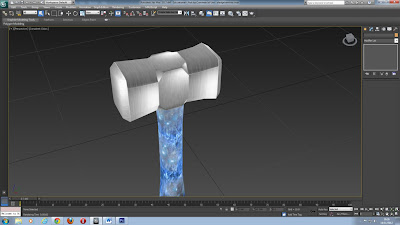Create a cylinder with 6 height
segments and then use the scale tool to squash it into a handle shape
Use inset by right clicking- then pick the amount and press
the green tick
Using the scale tool pull on the z axis
Using the edge tool select the middle horizontal line and
press loop- tick soft selection in the right menu and adjust the fallout to
adjust the degree that the shape is altered by from the middle
Using polygon mode select the very top of the handle and
Inset the top of the handle to create a guard
Click on one of the vertical edges at the very top and
select ring and then press polygon mode
Use
the bevel tool and group by local to pull out the selection and create a guard-
use the selection tool and pull up the z axis to shape the guard
Go down to polygon smoothing groups in the right menu and in
polygon mode select a polygon and then ctrl and A- click clear all
Drag a selection over the handle only and click on the
smoothing group 1
Select the bottom bevel and press alt and left click to
deselect the very bottom and then give it a smoothing group of 2
Select underneath the guard at the top and in polygon mode
and give it a smoothing group of 2, this different smoothing group from the
handle makes it stand out and become more defined when the light hits it from
the other parts of the handle
In polygon mode select a segment, hold shift and click
another segment to ring the selection quickly
Do the same for the rest of the guard- using a smoothing
group of 1 for the outside rim and 2 for the inside of it- they have to be
different smoothing groups if the parts are touching otherwise they blend into
one, losing the effect of the shadow
Go to the modify tool and select the shapes tab, go to the
line tool and create a sword shape about 6 units long
Right click on the line and convert it to an editable poly
Go to extrude and make the height very high, then in polygon
mode delete the end to make it hollow
In vertex mode select the 4 points of the sword which create
a rectangle and not the pointed part- then click bridge and pull them together
Select the first 2 vertexes down the face of the sword,
right click and the use the weld tool, getting them as close together as
possible
Using edge mode select the middle of the sword, right click
and select connect- use 8-10 segments
In vertex mode figure out which end is the pointed end and
then in the left wireframe view start to move the vertexes around so that it
looks more like a sword shape- do this until you’re happy with the shape of the
blade- try to make the vertexes line up
Go to edge mode and select one of the middle edges then
press loop, if only one side loops press ctrl and select an edge on the other
side then press loop again- pull out the sword on the x axis (red line) until
you’re satisfied with the width
Highlight the bottom sections using polygon mode and give
them a smoothing group of 3 on one side of the sword then do the same for the
other side but changing the group to 4
Do the top sections with a smoothing group of 1 and the
other side a smoothing group of 2
Unwrap the handle- select all of the handle apart from the
guard and the bottom bevel using the polygon tool- click on the cylinder
projection and then click fit and center
Click on the Y if your sword is facing in the direction of
the y axis
Unselect the cylinder projection


























































